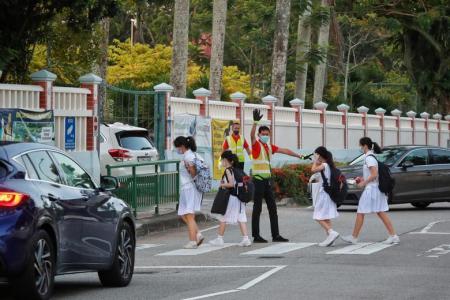Parents, stop chauffeuring your kid to school
The case of a reckless and arrogant Bentley driver who tried to force his way into Red Swastika School in Bedok on Tuesday (Jan 11) once again highlights the aggravation, congestion and pollution associated with schoolchildren being ferried to and from school by car.
Before I continue, I must confess that I, too, occasionally went to school in my dad's car. But back then, there were only two million people in Singapore, and fewer than 150,000 cars on the road - compared with 5.7 million people and around 650,000 cars today.
Public transport was also somewhat less developed back then. The MRT did not appear for another 20 years, while buses were often packed to a point where passengers had one foot on the steps and another hanging above the passing tarmac.
Today, Singapore has an enviable public transport system, with stark improvements in reliability, capacity and accessibility made in the last 10 to 15 years.
And if we really want to foster a car-lite way of life, what better way than to wean the next generation off their dependence on private transportation, and persuade young people that commuting by bus or train can be as efficient?
More than half of the 130 MRT stations here are near schools, or within a short bus ride away from one. With the high frequency of bus services and the implementation of distance fares, hopping onto a bus to the nearest train station is relatively painless.
Yet, we witness long lines of cars outside schools twice a day, five days a week. Parents or grandparents arrive an hour or even two hours earlier to be ahead of the queue, engines running so that they do not bake in the sun (an illegal practice, by the way).
Tailbacks of idling vehicles easily stretch for 200m, and sometimes take up two out of three useful lanes. The Traffic Police are regularly called in to control unruly queue jumpers and lane straddlers. But as soon as the cops go off, the bad behaviour returns.
Such scenes are replayed day after day, with the irony of nearby MRT stations - often linked to school compounds by sheltered walkways or underpasses - lost on the drivers.
Schools within walking distance to an MRT station include Maris Stella, St Nicholas, Singapore Chinese Girls' School, ACS, Nanyang Primary and, yes, Red Swastika.
The list is by no means exhaustive, but the schools cited here are near newer MRT stations. There has been no visible difference to the congestion caused by pupil-ferrying cars before and after the stations started operating.
At a time when new train stations are not completed or mothballed because of inadequate catchment - such as Hume, Mount Pleasant and Marina South stations along the Downtown and Thomson-East Coast lines - the unfulfilled potential of stations near schools does not gel.
The Circle Line's Bartley station is one such example. While patronage is expected to rise when the Bidadari HDB estate is fully completed in the next few years, the station has remained sparsely used since it opened in 2009.
To curb such wastefulness, can we find ways to persuade car-owning parents and grandparents that chauffeuring their charges to and from school is not a desirable practice, and that taking public transport can be more efficient than waiting in a line of cars?
If they deem their charges too young to take public transport by themselves, they can choose to accompany them. This way, they can see for themselves that taking the train or bus is not entirely unfeasible.
And if they must drive - in cases where public transport options are inordinately circuitous and long - they should find ways to drop off or pick up their charges in the least disruptive manner, such as turning into a nearby public carpark.
A short walk each day will also be good for junior, seeing how obesity is on the rise among children. The Weight Management Clinic at KK Women's and Children's Hospital saw a 12 per cent rise in overweight or obese children in the 12 months ended July 2021.
The masses walk as a matter of course. Six in 10 households do not have a car, and children in these homes have gone to school and back uneventfully over the years. So, it is quite conceivable that the minority can do so, too.
Besides fostering a healthier lifestyle and a car-lite generation, having schoolchildren take public transport builds independence and resilience.
It also helps to open the eyes of the 40 per cent to how the other half lives. And believe it or not, it can be fun too if one is in the company of friends - physically or virtually.
Children are tougher than we make them out to be. And for sure, there are far tougher tests in life than missing a bus or getting a little wet in the rain.
Why not teach them to use their own two feet, one step at a time? And by doing so, we can all make driving more pleasant for ourselves and others, as well as improve the environment for all.
Get The New Paper on your phone with the free TNP app. Download from the Apple App Store or Google Play Store now


